
Mayday, mayday, mayday.
Those words are some of the most feared on the fire ground. Once a mayday has been called, adrenalin starts pumping and a RIT is assembled to find those fallen brothers or sisters.
How many firefighters need help? Where was their last known position? What condition are they in? What’s the best route to take to reach them?
A group comprising Globe Manufacturing, Zephyr Technology Corp., TRX Systems Inc., Propel LLC and Skidmore College’s Health and Exercise Sciences Department has developed a program to help you answer those questions. The wearable advanced sensor platform (WASP) project combines location tracking and physiological monitoring technologies into an everyday station T-shirt. The shirt is outfitted with a location tracking and a physiological monitoring device, enabling researchers or incident commanders to track not only firefighters inside a building, but also their condition, specifically their breathing and heart rates.
“It’s about firefighter safety,” says Mark Mordecai, director of business development at Globe.
“We want to do as much as possible to make fire fighting as safe as possible, and we felt we had to go beyond that protective shell.”
The WASP project started as a research and development concept in 2006. The Worcester Polytechnic Institute in Massachusetts was working to determine if an integrated system was even possible. With interest from the United States military and other organizations, the project moved forward.
In 2008, Globe and its group moved to a trial period, during which they put early adaptions of the shirt on firefighters in Oxnard, Calif., and Boston. The group’s researchers collected data on the firefighters’ stress levels in real duty, and examined what their stress levels were like while on scene and while responding.
The researchers also learned about how the firefighters were wearing the shirts and determined that the comfort and general wearability of the shirts would be critical to the success of
the program.
Two years later, the U.S. Department of Defense expressed interest in the program, enabling it to move from a concept to a commercial system. Globe and its partners began to organize several field trials, including those in Champagne, Ill., Atlanta, Fairfax, Va., Annapolis, Md., and at the Texas Engineering Extension Service, part of Texas A & M University. Again, the group learned more about the program – what needed to be changed, what needed to be improved.
The WASP program completed field trials at the end of 2012, and was ready, as of July, to enter into beta testing at select training facilities. Several components have come together to make the device a wearable and functional piece of equipment.
The T-shirt
The T-shirt, and its structure and makeup, was important for the project. If it was uncomfortable, firefighters would be reluctant to adopt the technology. Propel LLC, a Rhode Island-based company that focuses on textile products for fire and military, was involved from the early stages of the project, developing the shirt, which is worn as a next-to-skin layer.
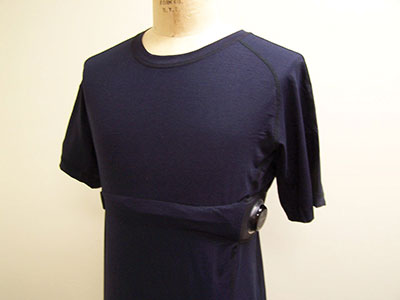 |
|
| The T-shirt is made of a moisture-wicking fabric, and is designed to be comfortable and pragmatic. The physiological monitoring puck is removed before the shirt is washed, though the remaining sensors and wires are washable.
|
The shirt has good flame resistance, dries quickly and features a moisture wicking technology.
“It’s designed to be passive,” Mordecai says.
“Put it on at the start of a shift and take it off after. [Firefighters should be able] to wear it on an everyday basis.”
Clare King, president of Propel, says the shirt also stands up to laundering, another important factor for departments to consider when adopting the technology.
“It can be washed several times without the fabric wearing and the seams breaking,” she says.
“The strap component – the physiological part that is integrated into the T-shirt – is washable. The data collection puck is removed before washing, but the rest of [the shirt] – the sensors, the connectors – are all washable.”
Furthermore, the shirt and all of its components can go through 100 wash/dry cycles before they begin to wear.
Location tracking
The location-tracking component uses inertial navigation – a more advanced version of the technology that flips the screen on your smartphone when you turn the device. The primary sensors involved include an accelerometer (inertial sensing), a gyroscope, a compass, a pressure sensor, an arranging sensor, a GPS and a light sensor.
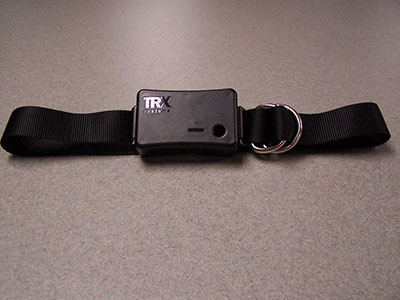 |
|
| This location-tracking device, developed by TRX Systems, uses several sensors to track a firefighter’s position inside a building. The device not only tracks the wearer’s location on a single floor, but also determines the wearer’s vertical location in the building. Photos courtesy globe manufacturing |
The greatest challenge for TRX Systems, which developed the location-tracking component, was pulling all that information down into a manageable size. The data is processed twice: first in a device that is small enough to be transported to the command centre – either a Motorola APX radio or an Android smartphone – and a second time to a laptop at the command centre.
William English, vice-president of product management at TRX Systems, says the result enables an incident commander to view all the available information at a command station.
“The command centre is where a decision maker can see all the information,” English says.
“[Users] can switch between a two-dimensional and a three-dimensional interface – you can move around the building [through the interface] to see everything. The 2-D mode presents information on a given floor, but the 3-D view can see the vertical distribution of people.”
The sensors not only provide information about the location of the wearer, but also offer an idea of the layout of the building – both as a two-dimensional representation of the floor, including various rooms and spaces, and as a three-dimensional representation of the entire building. This enables the incident commander to determine the floor on which the firefighter is working, as well as the vicinity of the firefighter on that floor.
“In terms of building visualization and accuracy, the more information that a user knows about a building, the more accurately [the system] can track,” English says.
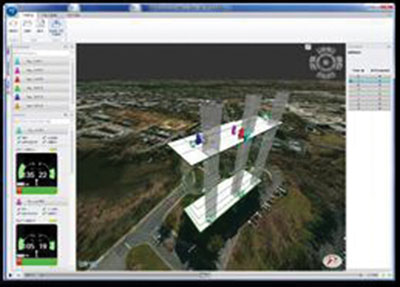 |
|
| This screenshot depicts what an incident commander can see while the system is running. The tracking device can map out the building in both 2-D and 3-D, providing a full idea of the building’s layout.
|
English recommends fire departments tour buildings in which radio communication isn’t very strong, or that departments have determined to be at a higher risk. That way, the system will be preloaded with the building’s layout.
“The system integrates known information about the building, but as a person walks through the building, the system can collect information about the building – it detects when you walk up stairs or get in an elevator. Then it can use that information.”
The greatest challenge that TRX faced was tracking the special movements that firefighters make – swinging an axe, or picking up a nozzle off the floor. These movements are more difficult to trace, though English says he and his team are constantly searching for improvements.
“Improving accuracy is something that we’re always going to be doing, and we’re constant going to be focusing our energy,” he says.
English said he sees this component being most useful in RIT situations. If a floor collapses, for example, the incident commander can tell on which level the downed firefighter has landed, and in which area or quadrant of the building.
According to Mordecai, the system can also be useful in a training situation.
“In training, you can make sure people are where they are supposed to be,” he says.
“For an after-action review, [training officers] can review tactics.
“On the fire ground, it’s about recovering a downed firefighter faster. Now you can send a RIT . . . and they can start in the right place and get to the firefighter a lot quicker and more effectively.”
Physiological monitoring
No technology exists to actually prevent a heart attack – not even in the most advanced hospitals – but Zephyr’s contribution to the WASP program can help chief officers determine the level of physical exertion at which their firefighters are working. The physiological monitor can determine if the wearer’s heart rate or breathing rate spikes or plummets.
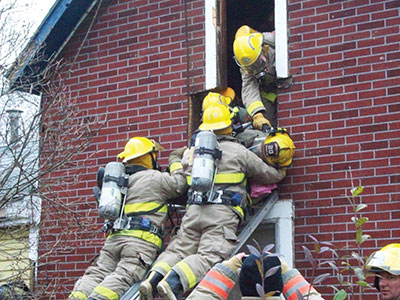 |
|
| The developers of the WASP program say they envision the system being most useful in mayday situations. A RIT will be more efficient if it knows exactly where a downed firefighter is, and what physiological condition he or she is in.
|
|
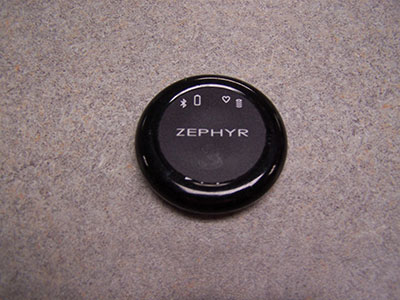 |
|
| This physiological monitoring puck, developed by Zephyr Technology, fits into the T-shirt and monitors both the firefighter’s breathing and heart rates. That information is then sent to a command centre where a chief officer can monitor the firefighter’s condition.
|
“It’s there to provide situational awareness,” Mordecai explains. “[The monitor] tracks stress and overexertion levels in real time.
“It allows the incident commander to monitor his firefighters, and where there is a set of physical factors that are outside the normal bounds, they can check on [the firefighter].”
It’s then up to the incident commander or chief officer who is monitoring the data, to decide on a course of action – maybe the firefighter needs to enter rehab sooner rather than later.
It should be made clear, Mordecai says, that the system cannot prevent cardiac events – nothing can do that. But it provides a set of data that can offer information about increased risk factors.
“It can be a great training tool,” Mordecai says. “It can help you understand what your firefighters are experiencing and help you to provide feedback.
“It is also useful in rehab to see what firefighters are going through and if they’re recovering normally.”
This type of monitoring is also a benefit in RIT situations. If a downed firefighter is unable to communicate, the incident commander can assess his or her vitals. Paired with the location-tracking device, a RIT can better access the mayday firefighter, and increase the chances of a successful rescue.
The WASP project entered beta testing in the summer at several facilities in the United States. Mordecai says the project will move to commercial systems for use at training centres before jumping into an operational environment.
“It’s important for us to put the tool in the hands of firefighters so they can figure out how to use it,” he says.
“From what we have seen in the field, there has been a tremendous interest in the fire service to do something about these problems.”
For more information on Globe’s WASP project, visit www.globeturnoutgear.com/innovations/wasp .
InterAgency Board Research & Development Priority
- Emergency responder body-worn integrated electronics system development: A body-worn electronics system integrating enhanced communications capabilities, locations and tracking capabilities, situational awareness and environmental sensing capabilities, physiological status monitoring capabilities, and respiratory protective equipment status.
- Enhance communications in environments that interfere with radio transmissions: Portable network extension of current radio capabilities into areas where coverage is prohibited by environment/terrain (e.g., tunnels, canyons, large structures, ships, etc.)
- 3-D tracking of personnel: Technology development for tracking and operating personnel in a 3-D environment. The research and development of 3-D tracking systems needs to continue until these systems are fielded.
The InterAgency Board in the U.S. released a list of 22 items slated for priority research and development. This chart provides brief descriptions of the top three items, two of which were incorporated into the WASP project. For the complete list, visit iab.gov/Uploads/2012-S&T-R&D-Priority-List-Descriptions.pdf .
Print this page